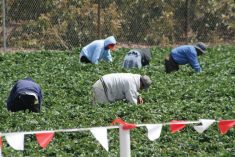With wildfire season underway and snow still on the ground, now is a good time to ensure your winter burns are completely extinguished.
“We typically see landowners burning as they try to clear woody debris off their land and turn it to agricultural purposes. We see windrows and machine-piled brush piles that are burned in the winter,” said Mike Tucker, wildfire prevention officer with Alberta Agriculture and Forestry.
Anyone who has conducted winter burning outside of wildfire season needs to closely examine any extinguished winter burn piles, he said.
Read Also

Moo translator and methane measures: There’s an app for that
Dalhousie University researchers use artificial intelligence to create new dairy farm apps that analyze cattle sounds and measure methane.
“You need to physically inspect the pile and check for heat,” said Tucker. “Take a metal rod or a stick, put it into the ash pile, pull it out and feel for heat. If there is any heat, the pile is likely still burning. That pile will then need to be spread or dug up to ensure it is out.”
Winter burn piles also need to be checked on a regular basis even if they seem to be out.
“Every spring we will have a few fires pop up unexpectedly on landowners,” he said. “They start grassfires and sometimes go into the trees. It is very important to be diligent after you have conducted winter burning.”
A fire caused by a winter burn could result in charges, court appearances and fines.
Tucker has some suggestions to set up burn areas more effectively, including encouraging landowners to use brush rakes on their machinery.
“They significantly reduce the amount of dirt that is going into the windrows and piles. Really dirty piles have a tendency to smoulder, not burn cleanly and hold on for months after the fact.”
The location is another factor.
“Don’t burn windrows on organic soils. Debris needs to be moved to high clay-type soils to prevent the burn getting into the peat.”
For more resources on winter burning and wildfires, go to farmfiresmart.ca, a resource created by Lac Ste. Anne County.
– With staff files















